Last month’s installment of the “The Art of Wine & Food” series at the Museum of Art Ft. Lauderdale was themed “Passion for Pinot” and featured three different Pinot Noirs from three well-known wine regions: Oregon’s Willamette Valley; California’s Anderson Valley; and Burgundy’s Cote d’Or. I thought it was apropos to use the word “passion” in the title due to the polarizing effect this grape has on its fans whose fierce loyalty to their favorite region/style rivals that of the most avid sports fan. Each of our featured wines was accompanied by a delicious dish created specifically to pair with it by Chef Remy Gautier of Argentelle Catering. So why compare Pinot Noir from three different regions? My wine loving friends, it all has to do with a little concept called terroir.
“Terroir“ (pronouced tare-WAHR) is a French term which, loosely translated, means “a sense of place.” With respect to wine, it refers to the intersection of grape variety, soil type, climate and winemaking technique which come together to create a unique wine that, theoretically, cannot be produced anywhere else in the world. The art of blind tasting is based upon this concept, that wines can look, taste and smell a certain way depending on where they are produced. This allows even wines made from the same grape to be distinguished from one another based on a region’s known characteristics (i.e. Pinot Noir from Burgundy would be more earth-forward while Pinot Noir from California would be more fruit forward). In short, if a wine is said to express terroir, the wine is believed to represent where it comes from and is considered a “wine of place.”

The purpose of featuring three different Pinot Noirs from three different regions was to illustrate the concept of terroir and demonstrate how these wines look, smell and taste different from one another even though they are made using the same exact grape. We started with the New World wine regions (Willamette and Anderson Valley) and finished with what is perhaps the birthplace of terroir: Burgundy, France. In 2oo AD, winemaking was introduced to this region located in east central France. While at first under the control of nobility, the vineyards of Burgundy eventually became the charge of the Catholic church. The Benedectine monks, specifically the Cistercians, were the first to realize different vineyards produced different wines and that not all of them were created equal. It is their observations which are responsible for creating the vineyard landscape of this world renowned wine region and establishing the framework for the Burgundy cru system.

The newer of our two New World wine regions was Oregon’s Willamette Valley which was represented by the 2010 Biggio Hamina “Zenith Vineyard” Pinot Noir ($42) from Eola-Amity Hills, one of the Valley’s sub-AVAs. The Willamette Valley was established in 1984 and is the largest AVA in the state of Oregon. This geographical region benefits from the winds off the Pacific Ocean that enter through the Van Duzer corridor, a gap in the Oregon Coast Range, which moderates warm summer temperatures. The name Eola is a tribute to the windy conditions in the area, and is derived from Aeolus, the Greek god of wind.
Biggio Hamina was founded in 2007 by winemaker Todd Hamina and his wife Caroline Biggio and this winemaker’s goal is to let the terroir do the talking. During positions at Archery Summit, Elk Cove and Patton Valley, Hamina worked with some of Oregon’s most renowned winemakers including Adam Campbell, Gary Andrus and Sam Tannahill. This valuable experience greatly informed his style of winemaking which he describes as non-interventionist and as “hands-off” as possible.
The Zenith Vineyard is a volcanic site with alluvial soils known for producing wines with notes of red fruit and minerals. During a conversations with Hamina he described 2010 as an optimal vintage and his decision to harvest was dictated strictly by physiologic ripeness and was not influenced by any adverse, external factors. The 2010 Hamina Zenith Vineyard Pinot Noir was 47% whole cluster fermented and spent 24 months in barrel, resulting in a wine with perfumed aromas of red fruit preserves, potpourri and smoky minerals, with an exotic black cardamom nuance. This wine has an elegant character with raspberry and cherry-cola flavors and finishes with lingering floral notes and a hint of minerality. It paired deliciously well with Chef Remy’s Warm Wild Mushroom Salad with Truffle Vinaigrette.

Our next New World wine region was California’s Anderson Valley and our representative was the 2010 Copain “Les Voisins” Pinot Noir. Established in 1983, the Anderson Valley is located 10-15 miles from the Pacific Ocean and has a cool, coastal climate with a wide diurnal temperature shift, meaning warm, sunny days followed by cool nights. The region’s soils are primarily alluvial with clay and, together with the climate, create optimal conditions for growing cool climate grape varieties such as Chardonnay and Pinot Noir from which both still and sparkling wines are produced.
Copain was founded in 1999 by winemaker Wells Guthrie who chose the French word for “friend” or “buddy” as his winery’s name, based on his belief wine is an experience best shared with friends and family. Guthrie was deeply inspired by his time spent in France’s Northern Rhône valley, apprenticing with the renowned Rhône winemaker Michel Chapoutier. Guthrie’s goal today is to make some of the most balanced, low alcohol, and food-friendly wines in California. He achieves this through combining French sensibility with California fruit, focusing on the Anderson Valley and Mendocino County.
“Les Voisins” is French for “the neighbors” and the grapes for this wine hail from three neighboring vineyards which are planted on Franciscan sandstone soils. 2010 was an unseasonably chilly vintage which meant a slower ripening of fruit which ultimately produced wines with more structure and acidity. The 2010 “Les Voisins” Pinot Noir was aged in neutral French oak barrels and has lovely aromatics of red fruit and spice. On the palate, flavors of red and black cherry, cassis, cedar and a dash of smoke accompany silky, supple tannins and a bright acidity. The flavors complemented Roasted Chicken with Mushrooms beautifully.

Our final Pinot Noir of the evening came from Burgundy, represented by the 2011 Vincent Girardin Pommard “Les Vignots” ($50) from the Cote de Beaune. It is important to note. however, that in Burgundy you will never find the words “Pinot Noir” on the label. Because wines produced here are all about place red Burgundy is always assumed to be Pinot Noir.
Vincent Girardin is the 11th generation of a winemaking family whose origins date to the 17th century. Girardin began his career in 1982 with only 5 acres of vines and he has since grown his holdings to 54 acres as of 2010. Girardin is known for his pure, focused wines which represent one of the few sources of vinous value in this prohibitively priced wine region. Much like his fellow Burgundians, Girardin’s goal is to produce wines which respect the individuality of their terroirs.
The most prized vineyards in Burgundy are located in the Côte d’Or which is divided into the Côte de Beaune and the Côte de Nuits. Pommard is a commune in the Côte de Beaune known for producing powerful, richly flavored red wines. “Les Vignots” is a vineyard parcel in this region whose vines are 65 years old and soils are comprised of limestone and clay. Fermentation begins with natural yeasts and the wine is aged in French oak (10% new) for 14 months. The 2011 Girardin Pommard “Les Vignots” has a purplish-red color with fragrant aromas of dark fruit, violet and wet earth. On the palate complex flavors of black cherry, raspberry, spice and earth accompany a bright acidity and lingering mineral and spice-tinged finish. It paired wonderfully well with the classic Boeuf Bourguignon.
A very special thank you to Hank Hill of Four Hills Media for the fabulous video of our evening and the photos for this post! To see more of his wonderful work please visit www.fourhillsmedia.com. For information on purchasing any of our featured wines, please visit The Wine Atelier, our online wine boutique by clicking here. This week we are sfeaturing a selection of Pinot Noir and are offering 10% off your Pinot purchase of $100 or more! To receive the discount, just enter the code PINOT10 at checkout, offer is good through Sunday. So what’s your favorite region for Pinot Noir? Do tell in the comment section below – I’d love to hear from you!
Cheers,
![]()
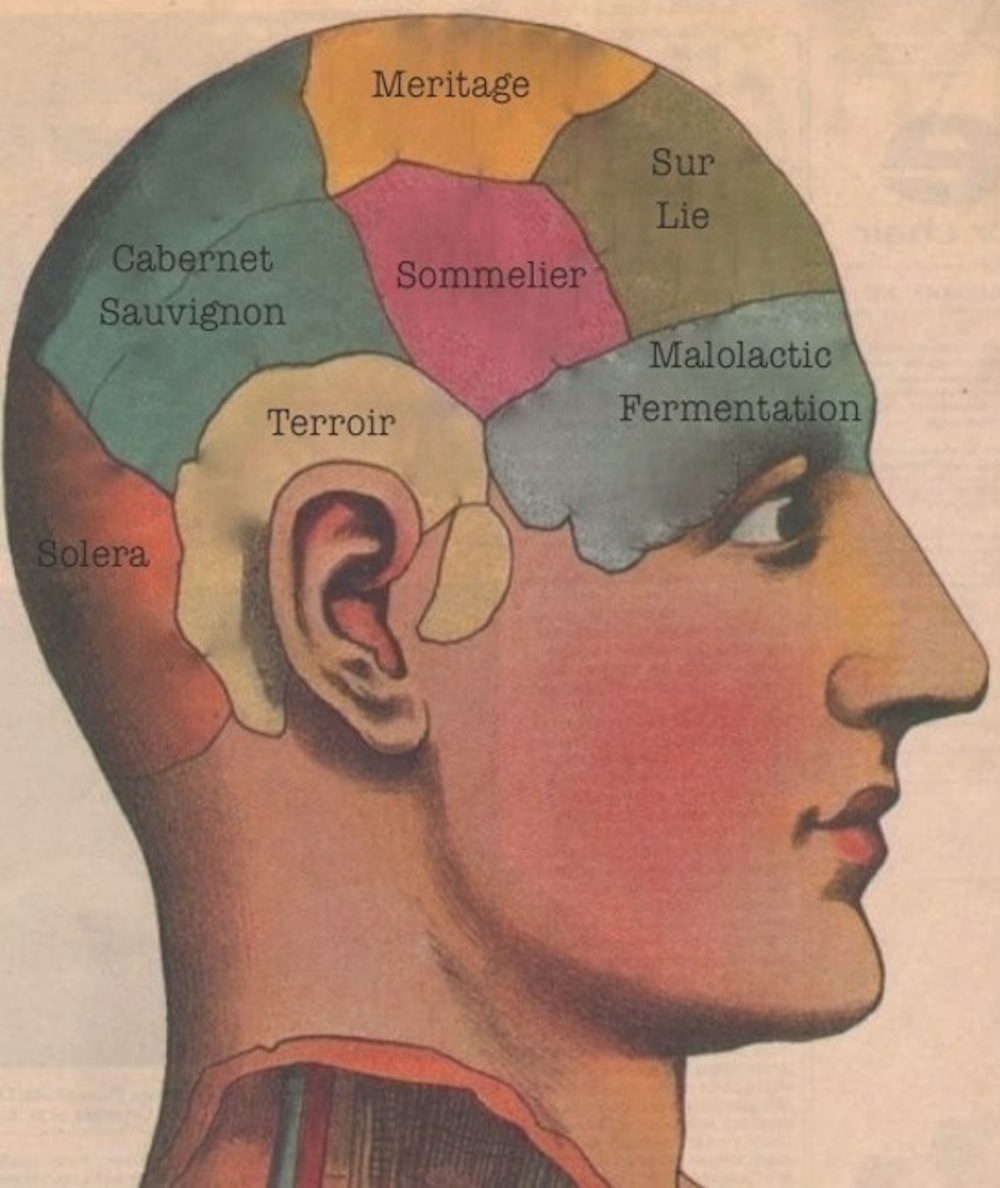
This week's Wine Word of the Week is Vin de Pays and was suggested by Meiers Tambeau of Atlanta, GA. Thanks for the suggestion, Meiers!Vin de Pays, or "country wine" in French, is one of the levels of the French wine classification system. It was created in 1973 and finalized in 1979 with the goal of creating a classification which recognized and encouraged the production of wines superior to basic vin de table wines while also acknowledging the wine's regional identity. Vin de pays is one level above Vin de Table (table wine) but below Appellation d'Origine Contrôlée (AOC) and is the French national equivalent of the Europe-wide IGP or Indication Géographique Protégée (Protected Geographical Region).For a wine to qualify as Vin de Pays it must conform to the standards of the classification and meet certain criteria. The wine cannot be blended, it must be produced in limited quantities, it must be made of certain specified grape varieties, it must reach a certain minimum alcoholic strength, it must come from a specified geographic region and it must be submitted to and approved by a tasting panel. The Vin de Pays classification benefits both producers and consumers in that it gives the consumers clarity regarding the wine's provenance and it allows producers the opportunity to produce wines outside the strict constraints of the traditional AOC laws. Perhaps the most significant to consumers here in the US is that wines classified as Vin de Pays are permitted to label the wine according to the grape variety. This allows consumers the opportunity to purchase a French wine labeled with a grape variety they are probably familiar with such as Chardonnay, Merlot or Cabernet Sauvignon.The Vin de Pays classification is further subdivided into three levels of geographic specificity. The top regional level has six divisions which roughly correspond to existing wine regions. These include: Vin De Pays du Jardin de la France (Loire); Vin De Pays de L'Atlantique (Bordeaux, Dordogne, Charentais); Vin de Pays du Comte Tolosan (South-West); Vin De Pays d'Oc (Languedoc-Roussillon); Vin De Pays Portes de Mediterranee (Provence and Corsica); and Vin De Pays des Comtes Rhodaniens (Rhone Valley, Beaujolais, and Savoie). The Languedoc-Roussillon produces more than three-quarters of all Vin de Pays wine and in 2006, it made five times more Vin de Pays than AOC wine produced that year.About 80% of Vin de Pays wines are red, while white and rosé make up the balance. All of these wines are produced from 300 pre-approved grape varieties which are comprised mostly of International varieties (i.e. Cabernet Sauvignon, Syrah, Merlot, Chardonnay and Pinot Noir). Under the 2009 changes, a Vin De Pays grape variety must comprise at least 85% of the stated variety on the label; where two varieties are stated on the label, they must constitute the full 100% of the blend.Thanks again for your suggestion, Meiers, and I hope that helps! If you (yes, YOU) would like to suggest a word for our Wine Word of the Week segment, please leave it in the comment section below or on our Facebook Fan Page which you can access by clicking here. If we use your word, your name will be entered into our monthly drawing to win one month of The Wine Atelier’s “Explorateur” Wine Club but remember – you have to play to win so make your suggestion now!Cheers,

This week’s Wine Word of the Week is Vin de Pays and was suggested by Meiers Tambeau of Atlanta, GA. Thanks for the suggestion, Meiers!
Vin de Pays, or “country wine” in French, is one of the levels of the French wine classification system. It was created in 1973 and finalized in 1979 with the goal of creating a classification which recognized and encouraged the production of wines superior to basic vin de table wines while also acknowledging the wine’s regional identity. Vin de pays is one level above Vin de Table (table wine) but below Appellation d’Origine Contrôlée (AOC) and is the French national equivalent of the Europe-wide IGP or Indication Géographique Protégée (Protected Geographical Region).
For a wine to qualify as Vin de Pays it must conform to the standards of the classification and meet certain criteria. The wine cannot be blended, it must be produced in limited quantities, it must be made of certain specified grape varieties, it must reach a certain minimum alcoholic strength, it must come from a specified geographic region and it must be submitted to and approved by a tasting panel. The Vin de Pays classification benefits both producers and consumers in that it gives the consumers clarity regarding the wine’s provenance and it allows producers the opportunity to produce wines outside the strict constraints of the traditional AOC laws. Perhaps the most significant to consumers here in the US is that wines classified as Vin de Pays are permitted to label the wine according to the grape variety. This allows consumers the opportunity to purchase a French wine labeled with a grape variety they are probably familiar with such as Chardonnay, Merlot or Cabernet Sauvignon.
The Vin de Pays classification is further subdivided into three levels of geographic specificity. The top regional level has six divisions which roughly correspond to existing wine regions. These include: Vin De Pays du Jardin de la France (Loire); Vin De Pays de L’Atlantique (Bordeaux, Dordogne, Charentais); Vin de Pays du Comte Tolosan (South-West); Vin De Pays d’Oc (Languedoc-Roussillon); Vin De Pays Portes de Mediterranee (Provence and Corsica); and Vin De Pays des Comtes Rhodaniens (Rhone Valley, Beaujolais, and Savoie). The Languedoc-Roussillon produces more than three-quarters of all Vin de Pays wine and in 2006, it made five times more Vin de Pays than AOC wine produced that year.
About 80% of Vin de Pays wines are red, while white and rosé make up the balance. All of these wines are produced from 300 pre-approved grape varieties which are comprised mostly of International varieties (i.e. Cabernet Sauvignon, Syrah, Merlot, Chardonnay and Pinot Noir). Under the 2009 changes, a Vin De Pays grape variety must comprise at least 85% of the stated variety on the label; where two varieties are stated on the label, they must constitute the full 100% of the blend.
Thanks again for your suggestion, Meiers, and I hope that helps! If you (yes, YOU) would like to suggest a word for our Wine Word of the Week segment, please leave it in the comment section below or on our Facebook Fan Page which you can access by clicking here. If we use your word, your name will be entered into our monthly drawing to win one month of The Wine Atelier’s “Explorateur” Wine Club but remember – you have to play to win so make your suggestion now!
Cheers,
![]()
If you're a fan of fashion, food & wine, and sunny South Florida, this glamorous trio is beautifully embodied in the latest addition to Miami's South Beach social scene, the Cavalli Miami Restaurant & Lounge.This establishment marks the first of its kind in the US for world-renowned Italian fashion designer Roberto Cavalli and his son Tommaso (pictured above). “The pleasure of listening to enjoyable music, accompanied by great food and good company in an elegant and sophisticated setting," is Cavalli's philosophy behind the new concept. Father and son also collaborate on their eponymous line of wines from their family-owned and run Tuscan estate, Tenuta Degli Dei, which were the focus of a recent wine dinner hosted by Tommaso at the new establishment.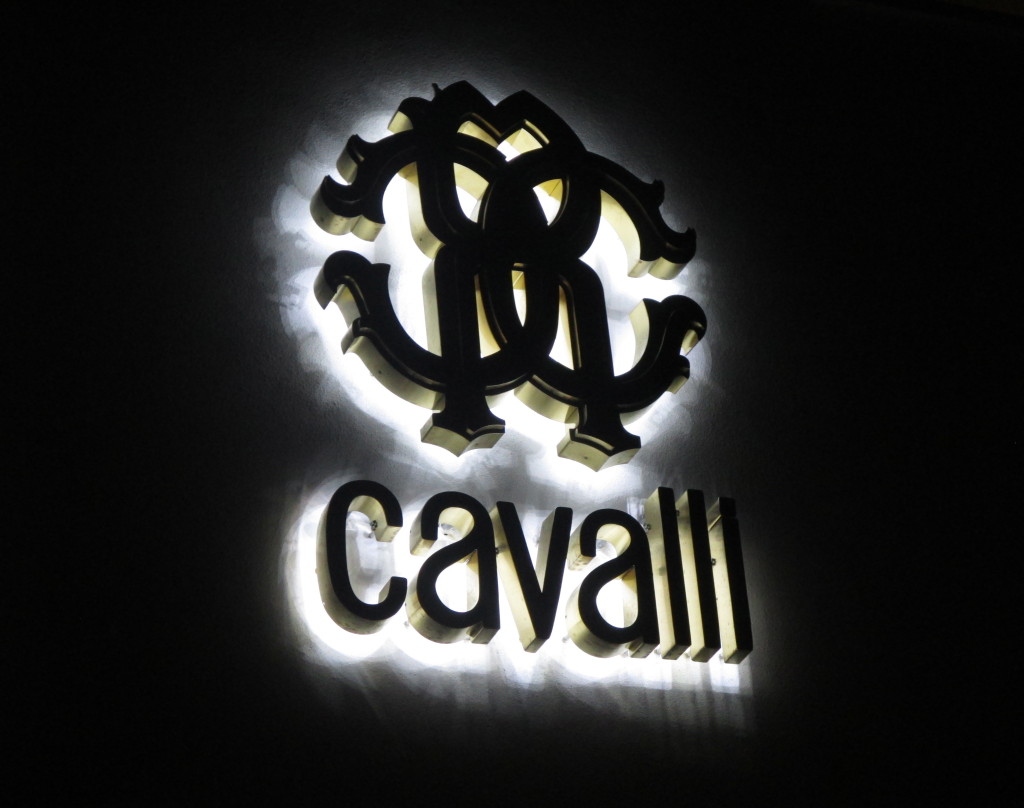
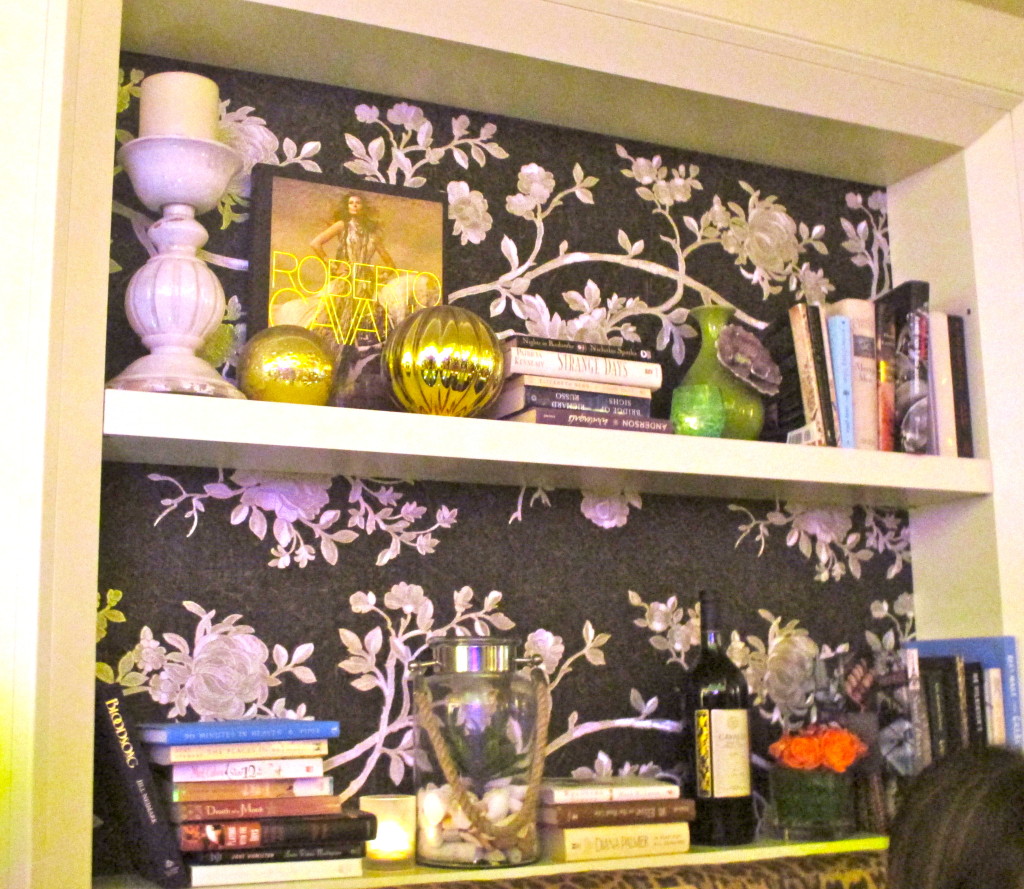 The designer's influence on the multi-level space located on Ocean Drive is immediately evident. The stark, "South Beach white" exterior features the unmistakable Cavalli logo backlit in neon white above the entryway. The interior is sultry and sophisticated with Cavalli's signature animal prints adorning the banquettes, tables and menus. Fashionable vignettes throughout the downstairs dining room feature bottles of the Cavalli wines displayed with glossy hardcover books, elegant decor elements and photos of Cavalli against a backdrop of brightly colored, floral patterned fabrics.While the downstairs dining room is fashionably chic, upstairs is clearly intended to be the hub of late night activity. Here, the swanky decor exudes South Beach's "club" vibe with a Cavalli-esque twist. Beveled mirrored walls reflect a backdrop of sumptuous velvet curtains while sleek black leather and leopard print seating areas surround a black lacquer DJ booth just beckoning you to get your dance on!
The designer's influence on the multi-level space located on Ocean Drive is immediately evident. The stark, "South Beach white" exterior features the unmistakable Cavalli logo backlit in neon white above the entryway. The interior is sultry and sophisticated with Cavalli's signature animal prints adorning the banquettes, tables and menus. Fashionable vignettes throughout the downstairs dining room feature bottles of the Cavalli wines displayed with glossy hardcover books, elegant decor elements and photos of Cavalli against a backdrop of brightly colored, floral patterned fabrics.While the downstairs dining room is fashionably chic, upstairs is clearly intended to be the hub of late night activity. Here, the swanky decor exudes South Beach's "club" vibe with a Cavalli-esque twist. Beveled mirrored walls reflect a backdrop of sumptuous velvet curtains while sleek black leather and leopard print seating areas surround a black lacquer DJ booth just beckoning you to get your dance on!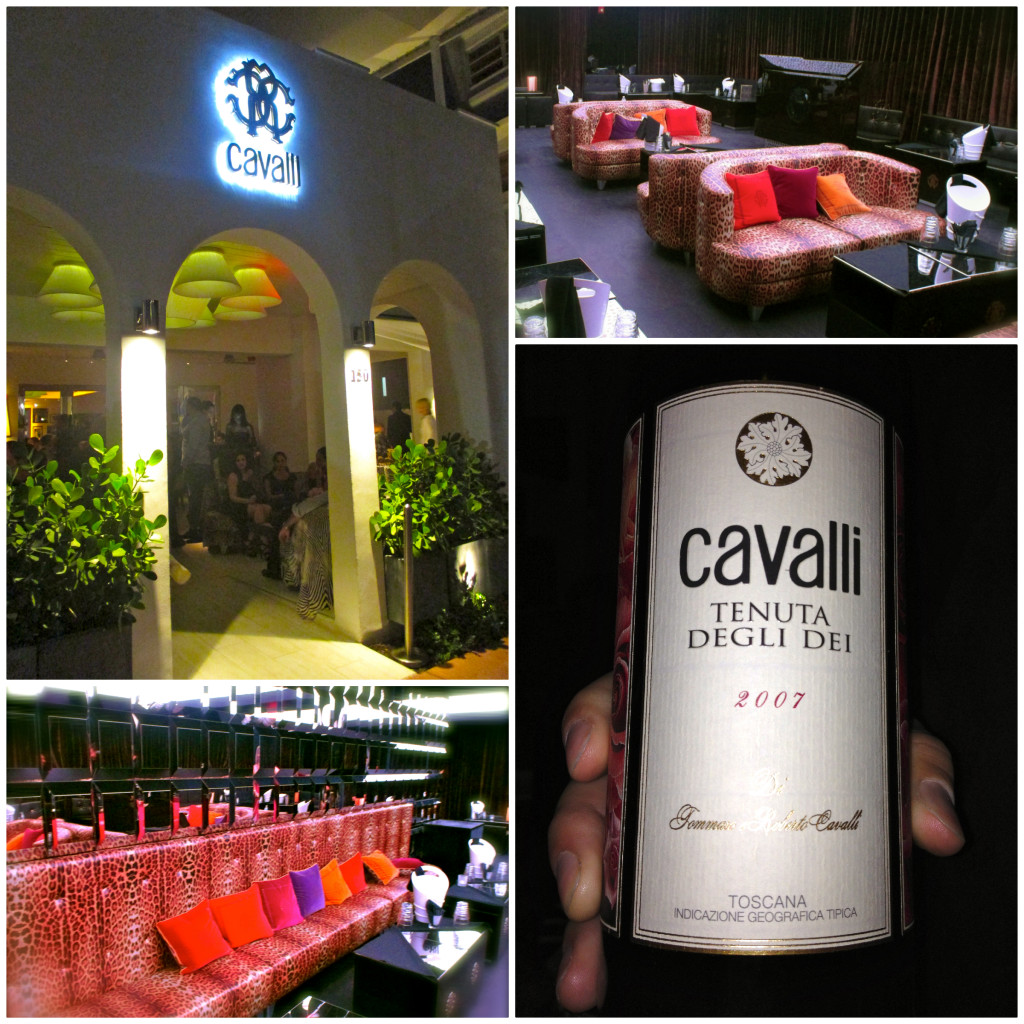 In addition to the ambiance, the food and wine were also quite fabulous. The tasting menu was paired with a selection of Cavalli wines crafted by winemaker Carlo Ferrini, Wine Enthusiast's 2007 Winemaker of the Year. Ferrini has created a critically acclaimed portfolio of wines and Sommelier Matias Benjamin Vergara guided us through the evening's selections which were paired with the deliciously authentic, Italian cuisine of Chef Stefano Mazzi.First was Tuscan Chianina Beef Tartare, featuring beef from one of the oldest cattle breeds in the world. Indigenous to Italy, Chianina beef is traditionally used to prepare the classic Tuscan dish Bistecca alla Fiorentina which is the perfect accompaniment for virtually all of Tuscany's red wines. The Chianina tartare was paired with the 2010 Tenuta Degli Dei "Le Redini" IGT, a blend of 90% Merlot and 10% Alicante. This supple red wine had aromas and flavors of red cherry, licorice and spice and complemented the flavor and texture of the meat beautifully.
In addition to the ambiance, the food and wine were also quite fabulous. The tasting menu was paired with a selection of Cavalli wines crafted by winemaker Carlo Ferrini, Wine Enthusiast's 2007 Winemaker of the Year. Ferrini has created a critically acclaimed portfolio of wines and Sommelier Matias Benjamin Vergara guided us through the evening's selections which were paired with the deliciously authentic, Italian cuisine of Chef Stefano Mazzi.First was Tuscan Chianina Beef Tartare, featuring beef from one of the oldest cattle breeds in the world. Indigenous to Italy, Chianina beef is traditionally used to prepare the classic Tuscan dish Bistecca alla Fiorentina which is the perfect accompaniment for virtually all of Tuscany's red wines. The Chianina tartare was paired with the 2010 Tenuta Degli Dei "Le Redini" IGT, a blend of 90% Merlot and 10% Alicante. This supple red wine had aromas and flavors of red cherry, licorice and spice and complemented the flavor and texture of the meat beautifully.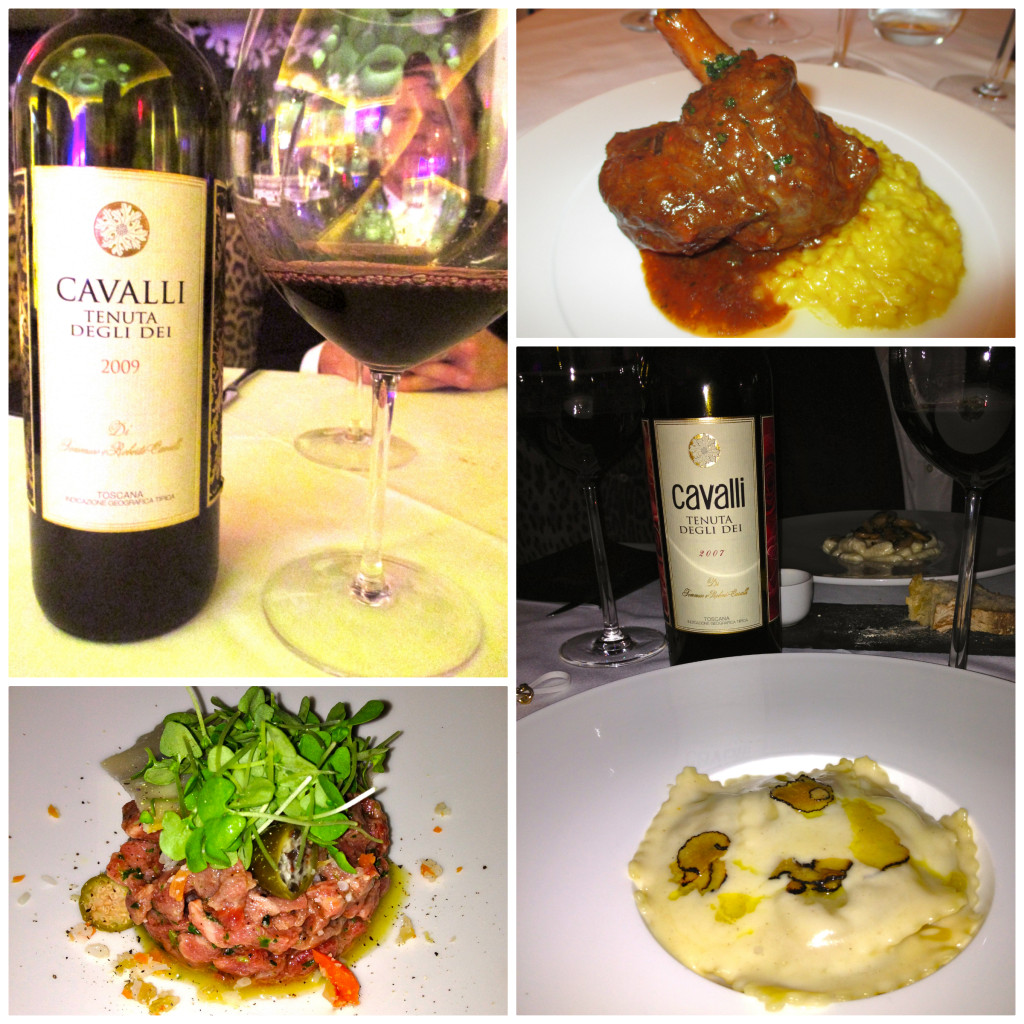 For the "Primi" or pasta course, heavenly Tuscan Wild Boar Ravioli was served with shaved black truffle and a decadent drizzle of truffle oil. The house-made ravioli were the perfect texture, melting in my mouth along with the flavorful, tender meat. This delicious dish was paired with the 2007 Tenuta Degli Dei IGT, a blend of Cabernet Sauvignon, Cabernet Franc and Petit Verdot aged for 18 months in French oak barrique. This wine had fragrant floral and dark fruit aromas while on the palate, flavors of blackberry, plum and spice accompanied a velvety texture, supple tannins, and a lengthy finish.For the "Secondi" or Main course Lamb Shank Osso Bucco with Risotto alla Milanese was flavorful and delicious. The risotto was cooked to perfection and the succulent lamb shank was perfectly tender and falling off the bone. The dish was paired with the 2009 Tenuta Degli Dei IGT, a blend of 60% Cabernet Sauvignon, 25% Cabernet Franc and 15% Petit Verdot. The wine had notes of violet, black currant, cherry, and spice with firm tannins and a bright acidity which stood up nicely to the rich osso bucco.Dessert consisted of Chocolate al Gianduia paired with the Tenuta Degli Dei Grappa, the perfect finale to a delicious evening. Next time you're in South Florida and feel like living "La Dolce Vita" spend an evening at Cavalli Miami Restaurant and Lounge. Who knows, after dinner you might even stay for a dance or two.Cavalli Miami Restaurant & Lounge 150 Ocean Drive Miami Beach, FL 305.695.4191 Dinner nightly from 6pm www.cavallimiami.comCheers,
For the "Primi" or pasta course, heavenly Tuscan Wild Boar Ravioli was served with shaved black truffle and a decadent drizzle of truffle oil. The house-made ravioli were the perfect texture, melting in my mouth along with the flavorful, tender meat. This delicious dish was paired with the 2007 Tenuta Degli Dei IGT, a blend of Cabernet Sauvignon, Cabernet Franc and Petit Verdot aged for 18 months in French oak barrique. This wine had fragrant floral and dark fruit aromas while on the palate, flavors of blackberry, plum and spice accompanied a velvety texture, supple tannins, and a lengthy finish.For the "Secondi" or Main course Lamb Shank Osso Bucco with Risotto alla Milanese was flavorful and delicious. The risotto was cooked to perfection and the succulent lamb shank was perfectly tender and falling off the bone. The dish was paired with the 2009 Tenuta Degli Dei IGT, a blend of 60% Cabernet Sauvignon, 25% Cabernet Franc and 15% Petit Verdot. The wine had notes of violet, black currant, cherry, and spice with firm tannins and a bright acidity which stood up nicely to the rich osso bucco.Dessert consisted of Chocolate al Gianduia paired with the Tenuta Degli Dei Grappa, the perfect finale to a delicious evening. Next time you're in South Florida and feel like living "La Dolce Vita" spend an evening at Cavalli Miami Restaurant and Lounge. Who knows, after dinner you might even stay for a dance or two.Cavalli Miami Restaurant & Lounge 150 Ocean Drive Miami Beach, FL 305.695.4191 Dinner nightly from 6pm www.cavallimiami.comCheers,

If you’re a fan of fashion, food & wine, and sunny South Florida, this glamorous trio is beautifully embodied in the latest addition to Miami’s South Beach social scene, the Cavalli Miami Restaurant & Lounge.
This establishment marks the first of its kind in the US for world-renowned Italian fashion designer Roberto Cavalli and his son Tommaso (pictured above). “The pleasure of listening to enjoyable music, accompanied by great food and good company in an elegant and sophisticated setting,” is Cavalli’s philosophy behind the new concept. Father and son also collaborate on their eponymous line of wines from their family-owned and run Tuscan estate, Tenuta Degli Dei, which were the focus of a recent wine dinner hosted by Tommaso at the new establishment.

The designer’s influence on the multi-level space located on Ocean Drive is immediately evident. The stark, “South Beach white” exterior features the unmistakable Cavalli logo backlit in neon white above the entryway. The interior is sultry and sophisticated with Cavalli’s signature animal prints adorning the banquettes, tables and menus. Fashionable vignettes throughout the downstairs dining room feature bottles of the Cavalli wines displayed with glossy hardcover books, elegant decor elements and photos of Cavalli against a backdrop of brightly colored, floral patterned fabrics.
While the downstairs dining room is fashionably chic, upstairs is clearly intended to be the hub of late night activity. Here, the swanky decor exudes South Beach’s “club” vibe with a Cavalli-esque twist. Beveled mirrored walls reflect a backdrop of sumptuous velvet curtains while sleek black leather and leopard print seating areas surround a black lacquer DJ booth just beckoning you to get your dance on!

In addition to the ambiance, the food and wine were also quite fabulous. The tasting menu was paired with a selection of Cavalli wines crafted by winemaker Carlo Ferrini, Wine Enthusiast’s 2007 Winemaker of the Year. Ferrini has created a critically acclaimed portfolio of wines and Sommelier Matias Benjamin Vergara guided us through the evening’s selections which were paired with the deliciously authentic, Italian cuisine of Chef Stefano Mazzi.
First was Tuscan Chianina Beef Tartare, featuring beef from one of the oldest cattle breeds in the world. Indigenous to Italy, Chianina beef is traditionally used to prepare the classic Tuscan dish Bistecca alla Fiorentina which is the perfect accompaniment for virtually all of Tuscany’s red wines. The Chianina tartare was paired with the 2010 Tenuta Degli Dei “Le Redini” IGT, a blend of 90% Merlot and 10% Alicante. This supple red wine had aromas and flavors of red cherry, licorice and spice and complemented the flavor and texture of the meat beautifully.

For the “Primi” or pasta course, heavenly Tuscan Wild Boar Ravioli was served with shaved black truffle and a decadent drizzle of truffle oil. The house-made ravioli were the perfect texture, melting in my mouth along with the flavorful, tender meat. This delicious dish was paired with the 2007 Tenuta Degli Dei IGT, a blend of Cabernet Sauvignon, Cabernet Franc and Petit Verdot aged for 18 months in French oak barrique. This wine had fragrant floral and dark fruit aromas while on the palate, flavors of blackberry, plum and spice accompanied a velvety texture, supple tannins, and a lengthy finish.
For the “Secondi” or Main course Lamb Shank Osso Bucco with Risotto alla Milanese was flavorful and delicious. The risotto was cooked to perfection and the succulent lamb shank was perfectly tender and falling off the bone. The dish was paired with the 2009 Tenuta Degli Dei IGT, a blend of 60% Cabernet Sauvignon, 25% Cabernet Franc and 15% Petit Verdot. The wine had notes of violet, black currant, cherry, and spice with firm tannins and a bright acidity which stood up nicely to the rich osso bucco.
Dessert consisted of Chocolate al Gianduia paired with the Tenuta Degli Dei Grappa, the perfect finale to a delicious evening. Next time you’re in South Florida and feel like living “La Dolce Vita” spend an evening at Cavalli Miami Restaurant and Lounge. Who knows, after dinner you might even stay for a dance or two.
Cavalli Miami Restaurant & Lounge
150 Ocean Drive
Miami Beach, FL
305.695.4191
Dinner nightly from 6pm
www.cavallimiami.com
Cheers,
![]()
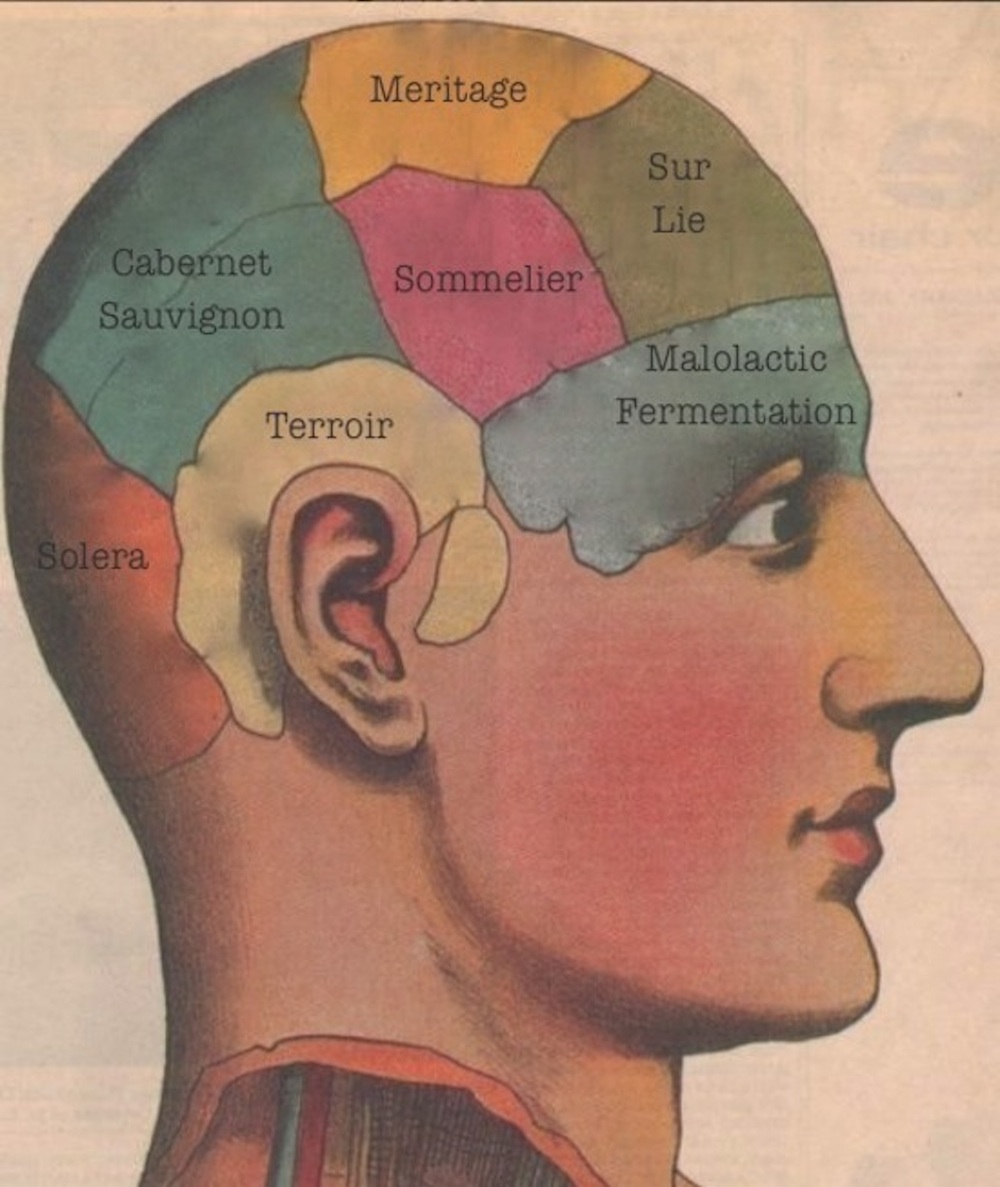
This week's Wine Word of the Week is "demi-sec" and was suggested by our fabulous Facebook Fan, Michelle Olson-Rogers - thanks for the suggestion, Michelle!Demi-sec is a French term which literally means "semi-dry" or "medium-dry" yet is used to refer to wines which are slightly to medium sweet. The term is usually used in association with wines from France's Champagne and Loire wine regions. In Champagne, the dosage, a mixture of wine and sugar added to the bottle following disgorgement, determines the final sweetness of the wine. So for a wine to be labelled as "demi-sec" the amount of sugar added can be anywhere from 35-50 g/l or 3.5-5% which is dictated by vinous law. The scale from driest to sweetest is (1) brut nature or sans dosage where no sugar is added, (2) extra brut, (3) brut, (4) extra dry, (5) sec, (6) demi-sec, and (7) doux which is the sweetest level. In the United States the different levels of sweetness do not have any legal definitions like they do in France.So next time you see a wine with "demi-sec" on the label, you know the wine in that bottle will be somewhat sweet. Oftentimes, especially with Champagne, the sweetness in the wine is balanced by a lovely acidity so the wine doesn't feel cloying on the palate. These delicious wines are perfect for serving with moderately sweet desserts and make an elegant addition to a dinner party.Thanks again for your suggestion, Michelle, and I hope that helps! If you’d like to suggest a word for our Wine Word of the Week segment please leave it in the comment section below or on our Facebook Fan Page which you can access by clicking here. If we use your word, your name will be entered into our monthly drawing to win one month of The Wine Atelier’s “Explorateur” Wine Club but remember - you have to play to win so make your suggestion now!Cheers,

This week’s Wine Word of the Week is “demi-sec” and was suggested by our fabulous Facebook Fan, Michelle Olson-Rogers – thanks for the suggestion, Michelle!
Demi-sec is a French term which literally means “semi-dry” or “medium-dry” yet is used to refer to wines which are slightly to medium sweet. The term is usually used in association with wines from France’s Champagne and Loire wine regions. In Champagne, the dosage, a mixture of wine and sugar added to the bottle following disgorgement, determines the final sweetness of the wine. So for a wine to be labelled as “demi-sec” the amount of sugar added can be anywhere from 35-50 g/l or 3.5-5% which is dictated by vinous law. The scale from driest to sweetest is (1) brut nature or sans dosage where no sugar is added, (2) extra brut, (3) brut, (4) extra dry, (5) sec, (6) demi-sec, and (7) doux which is the sweetest level. In the United States the different levels of sweetness do not have any legal definitions like they do in France.
So next time you see a wine with “demi-sec” on the label, you know the wine in that bottle will be somewhat sweet. Oftentimes, especially with Champagne, the sweetness in the wine is balanced by a lovely acidity so the wine doesn’t feel cloying on the palate. These delicious wines are perfect for serving with moderately sweet desserts and make an elegant addition to a dinner party.
Thanks again for your suggestion, Michelle, and I hope that helps! If you’d like to suggest a word for our Wine Word of the Week segment please leave it in the comment section below or on our Facebook Fan Page which you can access by clicking here. If we use your word, your name will be entered into our monthly drawing to win one month of The Wine Atelier’s “Explorateur” Wine Club but remember – you have to play to win so make your suggestion now!
Cheers,
![]()